
Back مجمع لاتران الرابع Arabic مجمع لاتران الرابع ARZ Conceyu de Laterano IV AST Чацвёрты Латэранскі сабор Byelorussian Concili del Laterà IV Catalan Čtvrtý lateránský koncil Czech Viertes Laterankonzil German Kvara Laterana koncilio Esperanto IV Concilio de Letrán Spanish Laterango IV. Kontzilioa Basque
| Fourth Council of the Lateran (Lateran IV) | |
|---|---|
 Matthew Paris' illustration in the Chronica Maiora of the Fourth Lateran Council | |
| Date | 1215 |
| Accepted by | Catholic Church |
Previous council | Third Council of the Lateran |
Next council | First Council of Lyon |
| Convoked by | Pope Innocent III |
| President | Pope Innocent III |
| Topics | Crusading, ecclesiastical reform, heresy, Islam, Judaism, laity |
Documents and statements | 71 papal decrees |
| Chronological list of ecumenical councils | |
| Part of a series on the |
| Ecumenical councils of the Catholic Church |
|---|
 |
| 4th–5th centuries |
| 6th–9th centuries |
| 12th–14th centuries |
| 15th–16th centuries |
| 19th–20th centuries |
|
|
The Fourth Council of the Lateran or Lateran IV was convoked by Pope Innocent III in April 1213 and opened at the Lateran Palace in Rome on 11 November 1215. Due to the great length of time between the council's convocation and its meeting, many bishops had the opportunity to attend this council, which is considered by the Catholic Church to be the twelfth ecumenical council. The council addressed a number of issues, including the sacraments, the role of the laity, the treatment of Jews and heretics, and the organization of the church.
In the case of Jews and Muslims, this included compelling them to wear distinctive badges to prevent social contact "through error". The council is viewed by medievalists as both opening up many reforms, and as formalising and enforcing intolerance in European society, both to heretics and Jews, and thus playing a role in the development of systemic European antisemitism.